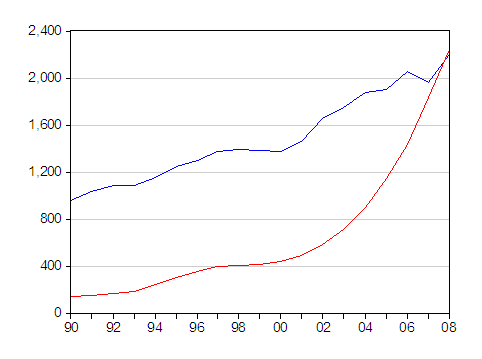What Are These Two Series?

Figure 1
The National Saving Identity states:
CA ≡ (T-G) + (S-I)
Where CA is the current account, (T-G) is the consolidated government budget balance, and (S-I) is the private sector saving-investment balance. Figure 1 depicts the profound shifts that have occurred in these components (normalized by nominal GDP).
In an Economix post today, titled “The Panic of ’08: Recession Cause or Effect?” Professor Mulligan writes:
…recent research questions the claim that the financial panics themselves contributed to their contemporaneous and severe employment downturns.
By Willem Thorbecke
Today, we’re fortunate to have Willem Thorbecke, Senior Research Fellow at Asian Development Bank Institute and a Consulting Fellow at Japan’s Research Institute of Economy, Trade and Industry, as a guest contributor.
Asia’s role in the propagation of the global recession has been a subject of study, but relatively little attention has been devoted to the interaction of exchange rates and production chains. The structure of East Asian production networks and the severity of the recession places a premium on policy coordination in the region.
I thought it of interest to see what surveys of forecasters indicate about two questions being asked: Is a dollar collapse imminent — Martin Wolf is skeptical, while others [0] are convinced the end is nigh — and is a double dip recession likely? I take a look at the messages conveyed by FX4casts.com and the WSJ October survey of forecasters.
From the abstract to Why are we in a recession? The Financial Crisis is the Symptom not the Disease!, by Ravi Jagannathan, Mudit Kapoor, and Ernst Schaumburg:
…We argue that the large increase in the developed world’s labor supply, triggered by geo-political
events and technological innovations, is the major underlying cause of the global macro economic
imbalances that led to the great recession. …
Paul Krugman recently characterized the current pace of trade activity as worse than that during the Great Depression. And indeed, Barry Eichengreen and Kevin O’Rourke have been diligent in illustrating how this is the case, most recently in this September VoxEU post. Caroline Freund ([pdf] here) as well as the IMF in its most recent World Economic Outlook (Box 1.1) attribute the sharp drop-off in world trade to high income elasticities, in part associated with the high degree of vertical integration that characterizes the globalized world economy. Below, I want to examine that explanation from the perspective of the US data. This follows up on several of my recent posts on the subject. [0] [1] [2] [3]
According to news accounts [0], rebalancing is going to be a central topic. Brad Setser, now in his official capacity as NEC/NSC director of international economics, blogs:
We will press the G-20 to agree on a framework for strong, balanced and sustainable growth. As the U.S. starts to act more responsibility, it will borrow less and spend a bit less on the rest of the world’s goods. That means borrowing by U.S. households cannot be the main source of global demand growth in the future.
These topics are the subject of two special issues, the first in IMF Staff Papers, and the second in the Review of International Economics.
The IMF has released its estimates for 2009Q1 reserves (COFER data). Below I update and extend my recent post on the dollar as a reserve currency.